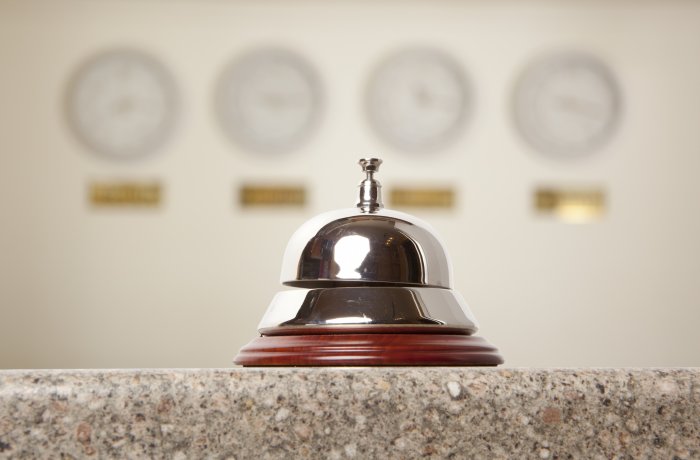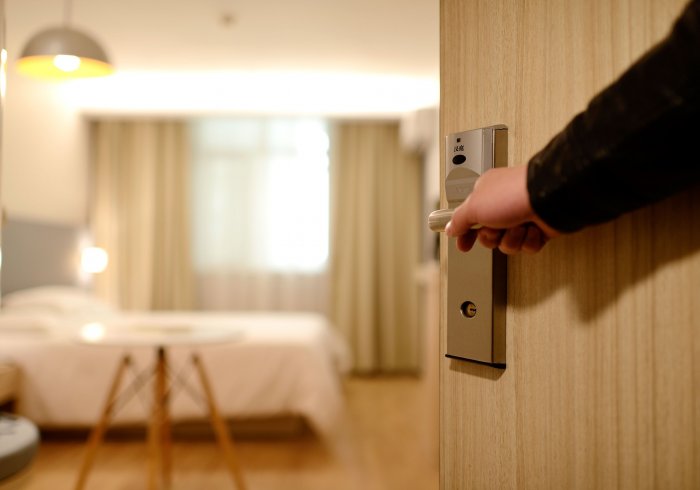Törley to Commemorate 140 Years of Bubbly in Budafok
Guide Pólika Szabó takes some time out of the cool passages of the museum to enjoy the park outside the Törley sparkling wine cellars in Budafok.
Photo by Kester Eddy
Hungary’s leading pezsgő producer hopes its celebrations will help visitors learn that Budapest has tourist attractions far beyond the popular central party district.
Budafok, a full 11 kilometers southwest of central Budapest, is largely off the itineraries of tourists visiting the Hungarian capital.
True, from a distance, this moderately wealthy suburb of 55,000 souls looks fairly hum-drum and much like any other on the Buda side of the Danube. Yet once atop the railway bridge that forms a man-made barrier on the approach from the north, the observant visitor will spot the spires and turrets of a Disney-like chateau amidst the 1970s housing blocks, while a glance up the hill behind appears to host something akin to a mosque.
Both buildings give an air of unexpected mystery and intrigue to Budafok, and both are inextricably linked to the legacy of one entrepreneurial innovator who, in the late 19th century, brought fame and fortune to his adopted home.
József Törley was born of ethnic German stock in 1858 in what is today northern Serbia. After studying in Graz, Austria, he set off in the 1870s for Reims, France, to work as an apprentice winemaker in the capital of Champagne country.
The young Törley was quick to pick up the skills of making bubbly and soon founded his own winery in France before taking a trip to Hungary in search of grapes suitable for producing fine sparkling wines.
To his delight, in Etyek, 30 km west of Budapest, he not only found grapes growing in Champagne-like soil and climate but in Budafok, then just a village outside the capital’s boundary, he also discovered cellars ideal for fermenting and storing sparkling wines.
The twin finds gave Törley pause for thought: why go to all the trouble and risk of shipping grapes 1,400 km from Hungary to France when there were cellars near Etyek perfect for making a product to compete with Champagne?
So it was that within a matter of months, the mercurial Törley was busy selling his business in Reims and setting up shop in Budafok, bringing with him Louis François, a renowned Champagne winemaker, to act as his cellar master.
Winery Tour
Telling this story, and the subsequent ups and downs of Törley’s brainchild, is the daily work of Pólika Szabó, a tour guide at the winery’s museum.
Szabó, in awe of the company’s founder, enthusiastically describes how in the early 1900s, he imported two of the very first commercial motor trucks into Hungary.
“In those times, everybody used horse-drawn carts and coaches. He bought the trucks in France and drove them back to Hungary, but he painted the Törley [logo] on the sides for marketing. I wanted so much to meet József Törley; he was very innovative, with a lot of energy,” she says.
He also employed innovative marketing techniques at home: Once the first vintage of sparkling wines was ready for sale, Törley hired the best graphic artists to design posters, many displaying beautiful women in the best fashion of the day, to create an allure of high-class sophistication around the brand.
Nor was he averse to employing more dubious marketing ploys. As his fame grew, if a restaurateur of note declined to stock his wines, Törley would send friends to dine at the reluctant establishment with instructions to order his wines and, once it transpired the “famous brand” was not available, create a loud, shameful fuss to embarrass the owner into line.
Törley’s exuberant, non-stop nature may not have suited all involved, however. Within a few years, his French cellar master, dissatisfied with the remuneration on offer, went independent, setting up a competing winery next door to his former employer, although the two remained on speaking terms.
The François winery also proved successful yet seemingly did little to harm Törley, who powered on, his revenues funding the construction of the opulent chateau with spires and turrets behind the wine cellars that grace Budafok to this day. (The mosque-like building on the hill is the family mausoleum, though it’s not entirely clear when that was built.)
Soon into the museum tour, Szabó points to a book created in 1907 to document the company’s first 25 years of existence as part of the celebrations organized by Törley. By the standards of the time, it was undoubtedly fast development.
Company Succession
Yet the founder would play little further part in his company nor profit from its success. Within weeks, on holiday in Belgium, he died of appendicitis on a train in Belgium and, lacking a direct heir, his brother took the company over.
The company continued to flourish, producing two million bottles of wine in 1910, before war, depression and war again stymied development. The cellars were hit by allied bombing in the summer of 1944 (almost certainly by accident, the target being the Manfréd Weiss Steelworks, 200 meters distant across the Danube). Then, following “liberation” by the Red Army in 1945, only a handful of employees stayed to sell off stocks before the communist state nationalized the company in 1950, with Törley’s descendants forced into exile in the Hortobágy, in rural eastern Hungary.
Yet, with the demise of Stalinism, a more pragmatic form of communism enabled a revival of the company, though still state-owned, from the late 1950s.
Today, after the change of system in 1990, Törley, owned by the German Henkell & Söhnlein sparkling wine company since 1992, is once again flourishing, with a clutch of brands, including François, named for the original cellar master, Hungaria, and BB, and producing some 21 million bottles of sparkling wine annually.
Following the inevitable dearth of visitors as a result of the coronavirus pandemic, Szabó is hopeful of a revival of visitors to the museum, essentially Budafok’s principal tourist attraction, to learn about the history and technology of sparkling wine, not to speak of the tasting at the end of the tour.
Gabriella Balogh, PR and product manager, plans special celebrations to commemorate the 140th anniversary of Törley Sparkling Wine, which will certainly focus attention on the company.
“We are having a big party for three days. You can come; it’s the first weekend of September,” she says.
Getting to the Törley Museum
The museum is at Anna utca 7, in Budafok, part of Budapest’s XXII district. Hungarian State Railways (MÁV) runs a regular suburban service to Budafok from Budapest’s Déli Railway Station, but the best means by public transport are probably tram 47 (from central Pest) and tram 56 (from Buda). The closest station for the museum is Leányka utcai lakótelep, two stops before the terminus at Városház tér, but if you miss the stop, it’s only a short walk back. The 33 and 133E buses also run to Budafok, and stop at Leányka utcai lakótelep.
Visitors should book times via the museum websites: torleymuzeum.hu/en/visiting-in-groups. Guided tours for groups up to a maximum of seven persons start at HUF 38,000, but rise according to the number of wines to be tasted. Warm clothing is advised. Note that the museum is part of the premises that house the working Törley cellars, and guests might be asked to explain their purpose on entry to the gateman.
This article was first published in the Budapest Business Journal print issue of July 1, 2022.
SUPPORT THE BUDAPEST BUSINESS JOURNAL
Producing journalism that is worthy of the name is a costly business. For 27 years, the publishers, editors and reporters of the Budapest Business Journal have striven to bring you business news that works, information that you can trust, that is factual, accurate and presented without fear or favor.
Newspaper organizations across the globe have struggled to find a business model that allows them to continue to excel, without compromising their ability to perform. Most recently, some have experimented with the idea of involving their most important stakeholders, their readers.
We would like to offer that same opportunity to our readers. We would like to invite you to help us deliver the quality business journalism you require. Hit our Support the BBJ button and you can choose the how much and how often you send us your contributions.








